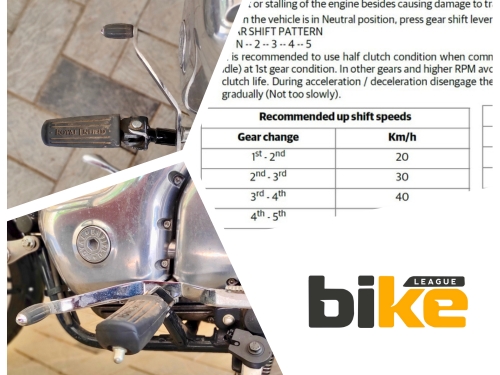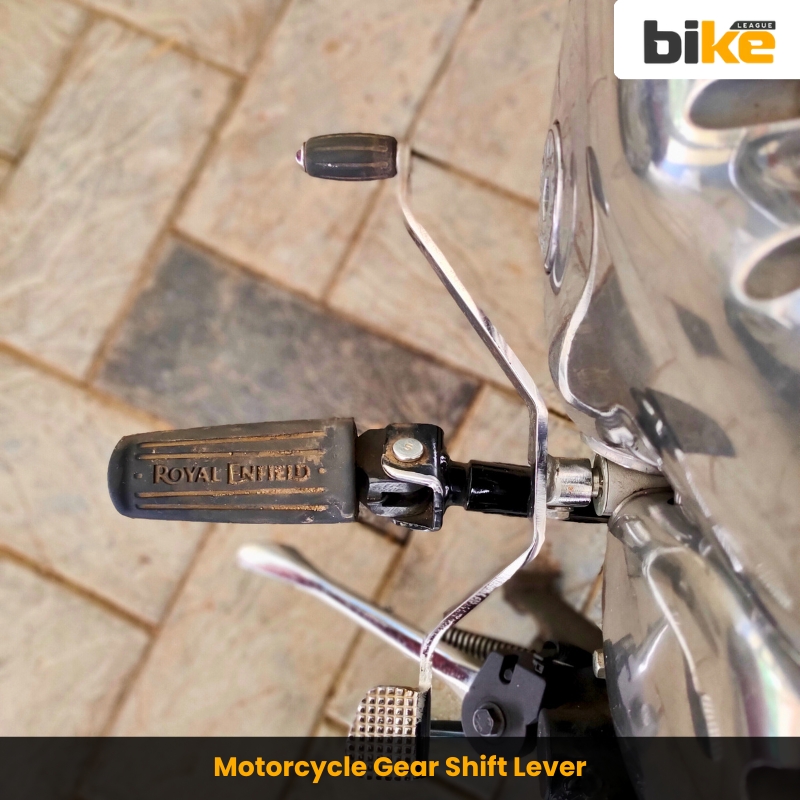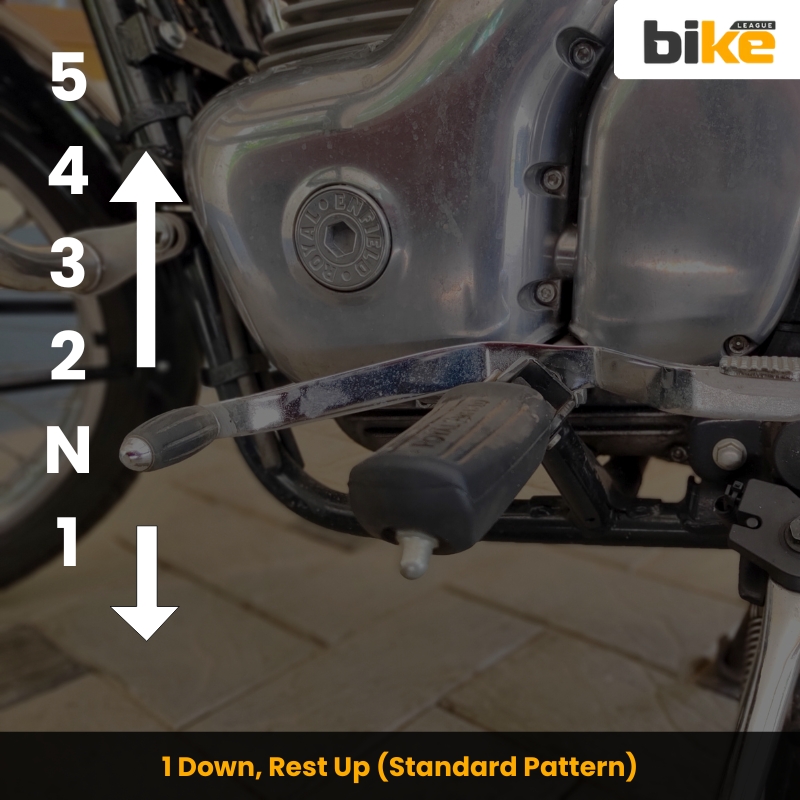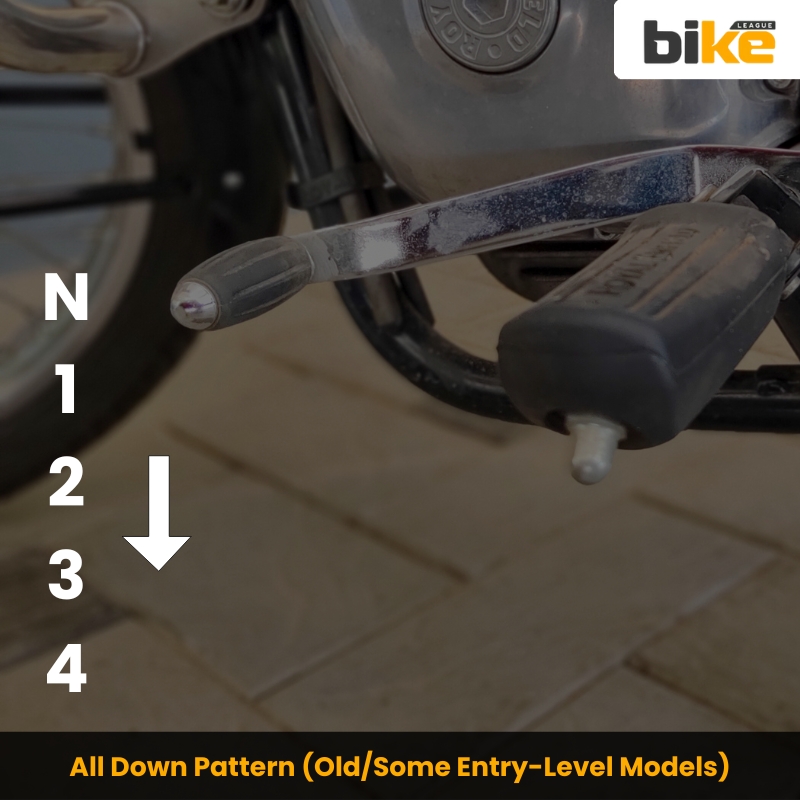
Long story short: Learn about different types of motorcycle gear shift patterns, their pros and cons, and the safety reasons behind neutral gear placement on Indian bikes.
In India, motorcycles have different gear shift patterns, depending on the model and the rider’s needs. Neutral is set between 1st and 2nd gear to make riding safer and more comfortable. Here are the basics.
Key Takeaways
- A gear pattern shows the order in which you select gears with the shift lever. Most Indian bikes use the ‘one down, neutral between 1st and 2nd, then the rest up’ setup, like 1-N-2-3-4-5.
- 1 Down Rest Up motorcycle gear shift pattern: 1-N-2-3-4-5 (sometimes 1-N-2-3-4) – Most prevalent among commuter bikes, sport bikes, and premium motorcycles.
- All down motorcycle gear shift pattern: N-1-2-3-4 – Used primarily on older motorcycles or small-capacity commuters.
- Semi-Automatic/Sequential: Pattern: 1-2-3-4 – no neutral between gears, often found in scooters or mopeds.
- Reverse/Race Pattern (Rare, for Track Use): 1 Up, Rest All Down – This pattern is hardly ever seen on Indian roads. It’s mainly used in racing bikes, where quick gear changes are most crucial.
What is a gear in a motorcycle?
A gear in a motorcycle is a toothed part that connects with other gears to send power from the engine to the back wheel. This setup lets you change speed and power, so the bike works well in different situations.
Lower gears give more power for quick starts and going uphill. Higher gears help you go faster with less engine effort, which saves fuel
What is a gear system in a motorcycle?
A motorcycle’s gear system includes the gearbox with its gears, the clutch for disconnecting engine power when shifting, shift forks that move the gears, a shift drum that guides the forks, and the gear shift lever you use with your foot.
When you use the gear lever, parts inside the bike move the gears into position. This affects the bike’s speed and the amount of power it produces.
What is a gear pattern in a motorcycle?
A gear pattern shows the order in which you select gears with the shift lever. Most Indian bikes use the ‘one down, neutral between 1st and 2nd, then the rest up’ setup, like 1-N-2-3-4-5.
This order allows you to easily control your speed. Neutral sits between 1st and 2nd gear on purpose, so you don’t accidentally shift into neutral while riding and can keep the bike in gear at low speeds.
Different types of motorcycle Gear shift patterns in motorcycles in India
1. 1 Down, Rest Up (Standard Pattern):
- Pattern: 1-N-2-3-4-5 (sometimes 1-N-2-3-4).
- Most prevalent among commuter bikes, sport bikes, and premium motorcycles.
- Models: Hero Splendor, Bajaj Pulsar, Honda Shine, Suzuki Gixxer, Royal Enfield Classic 350.
Pros
- The standardised design across modern motorcycles makes it easy for riders to switch between bikes.
- Riders find this pattern intuitive and quick to use, especially in traffic, with up-shifting by toe movement reducing mis-shifts.
- Downshifting into 1st gear always engages power, improving safety during stops and emergencies.
Cons
- Beginners might find it tricky to find neutral because it takes a gentle lift between the 1st and 2nd. If you shift up too far from 1st, you might end up in neutral by mistake, which can be confusing.
- If you shift up too far from 1st gear, the bike can slip into neutral, which can be confusing if you’re not paying attention.
2. All Down Pattern (Old/Some Entry-Level Models)
- Pattern: N-1-2-3-4.
- Used primarily on older motorcycles or small-capacity commuters.
- Models: Hero CD Deluxe, some old Bajaj models.
Pros
- Neutral can be accessed quickly at signals and stops, which reduces the time needed to disengage engine power.
- The pattern is straightforward for new riders familiarising themselves with gear changes.
Cons
- If you downshift quickly in an emergency, you might land in neutral. This takes away engine control and can be unsafe.
- This pattern is no longer used, so it can be confusing if you switch to a newer bike.
3. Semi-Automatic/Sequential:
- Pattern: 1-2-3-4, no neutral between gears, often found in scooters or mopeds.
- Models: Honda Activa (CVT, gearless), TVS XL100 (no clutch, sequential manual).
Pros
- The absence of a clutch lever makes operation more manageable for beginners and urban commuters.
- Simplifies mechanical operation, speeding up gear changes.
Cons
- With this system, you have less control over the bike, making it less suitable for sporty riding or changing road conditions.
- You’ll mostly find this setup in mopeds and a few scooters, so it’s not as versatile as other patterns.
4. Reverse/Race Pattern (Rare, for Track Use)
- Pattern: 1 Up, Rest All Down.
- This pattern is hardly ever seen on Indian roads. It’s mainly used in racing bikes, where quick gear changes are most crucial.
Pros
- The reverse pattern allows racers to shift up faster without having to move their foot much, which is particularly helpful during aggressive riding on the track.
- Minimises the toe movement required for performance riding.
Cons
- Riders accustomed to standard patterns may find this pattern confusing and make gear selection mistakes. The pattern is rare in street bikes, making service and support more difficult to find in India.
- You won’t often see this pattern on regular bikes, and it’s challenging to get help for it in India.
| Pattern | Pros | Cons | Example Models |
|---|---|---|---|
| 1 Down, Rest Up | Easy for beginners, standardised, reduces mis-shifting, good for city & highway; upshifting is toe-friendly | Finding neutral can be tricky; can require finesse at signals | Hero Passion XPro, Bajaj Pulsar, Honda Shine |
| All Down | Quick neutral access at signals or stops | Less safety in panic downshifting (can land in neutral by mistake), less control at low speed | Old Bajaj, Hero CD Deluxe |
| Semi-auto/Sequential | Simplicity, no clutch lever needed; easy for new riders | Limited control, reduced performance | TVS XL100, Honda Activa |
| Race/Reverse Pattern | Faster shifts on track, toe-only action | Confusing for road riders, rarely seen on streets | Imported race bikes |
Why is the neutral gear between 1st and 2nd gear in motorcycles?
Neutral gear is positioned between 1st and 2nd gears in motorcycles, primarily for safety, control, and ergonomic reasons.
1. Safety in Emergencies
With 1st gear at the bottom, if you quickly downshift in a panic, like when stopping or going downhill, you’ll always end up in a gear that keeps the engine connected to the wheels. This helps you stay in control at low speeds. If neutral was at the bottom, you could lose engine power during emergency downshifts, which could make the bike unstable and increase the risk of accidents.
2. Reduced Unintentional Shifts
Since neutral is above 1st gear, it’s harder to shift into neutral by accident while riding or stopping. You have to make a careful half-click to get there, not just press down. This setup makes the transmission more reliable and helps prevent losing power when you need it most.
3. Practical Control
parking or idling, and you can always pull in the clutch if you need a quick break from the engine. Having neutral between the main gears makes it easy to reach without getting in the way of everyday riding.
In short, today’s gear setup is designed to give riders better control, safety, and practical use in all kinds of riding situations.
What is the relation between gear and mileage in motorcycles?
The gear you use has a significant effect on your bike’s mileage. Gears change how much power and speed are transferred to the back wheel, which affects the amount of fuel you use.
1. Lower Gears (1st, 2nd)
Lower gears give you more power but less speed. They use more fuel because the engine works harder, so you get less mileage. These gears are primarily designed for starting, riding at low speeds, or climbing hills.
2. Higher Gears (3rd, 4th, 5th, 6th if available)
Higher gears allow the engine to run at slower speeds and at higher speeds, which saves fuel and improves mileage. Using these gears at the right time helps you get the best fuel efficiency.
3. Neutral Gear
Disengages the engine from the wheel and does not contribute to fuel efficiency or mileage. It is used only when the bike is stationary or idling.
4. Optimal Gear Shifting
If you match your speed and gear well, the engine works at its best and uses less fuel. Riding in the wrong gear at too high or too low RPM can waste fuel.
What are the specific reasons for the declining use of the all-down pattern in modern motorcycles in India?
Modern motorcycles in India are shifting away from the ‘all down’ gear pattern due to practical reasons, safety concerns, and riders’ preferences.
1. Safety Concerns
Suppose you shift into neutral by mistake during a quick downshift, like in an emergency. In that case, the bike can lose engine braking and power. This makes it harder to control and can lead to accidents.
2. Standardisation and Training
Worldwide, the ‘one down, rest up’ pattern is now the standard, and rider training follows this too. It helps riders avoid confusion when switching bikes and ensures consistent safety practices.
3. Modern Transmission Design
Today’s gearboxes are built for smoother, more reliable shifting with the 1-down, rest-up setup. The all-down pattern doesn’t work as well with new features like multi-plate clutches and better shifting systems.
4. Rider Ergonomics
The standard pattern is easier on your feet and allows you to change gears quickly and intentionally. It also helps you avoid mistakes and gives better feedback while riding.
5. Market and User Expectations
Today’s riders expect convenience, safety, and conformity to international norms. Manufacturers aim to deliver a familiar and expected experience across various segments, making the all-down pattern obsolete.
All these reasons have made the ‘1 down, rest up’ pattern the most common in India, as it’s safer, easier to use, and matches global standards.
FAQ about Motorcycle Gear shift Patterns
1. What are the different gear shift patterns used in motorcycles?
There are mainly five types: 1 Down–Rest Up (1–N–2–3–4–5), All Down, All Up, Rotary (N–1–2–3–4–N),and Reverse/Race Shift (N–1–2–3–4–5).
2. Which gear pattern is most common in Indian motorcycles?
Most Indian motorcycles—from Hero, Honda, TVS, Bajaj, and Royal Enfield—use the 1 Down–N–Rest Up pattern because it’s easy to operate and globally standardised.
3. Why is the neutral gear between 1st and 2nd gear?
This design enhances safety and control—it prevents riders from accidentally shifting to neutral while the vehicle is in motion. It enables safe stopping or starting in 1st gear.
4. Which bikes in India use a rotary gear pattern?
Entry-level commuter bikes and mopeds, such as the TVS XL100, Honda CD110 Dream, and older Hero Splendour models, use the rotary pattern (N–1–2–3–4–N).
5. How does the gear lever function in a motorcycle?
The gear lever, operated by the left foot, connects to a shift drum inside the gearbox. Press down to engage 1st and lift up for higher gears via a sequential mechanism.
6. What happens if you accidentally skip gears while shifting?
Sequential transmissions in motorcycles prevent actual gear skipping, but stepping too hard or too light may cause a false neutral between gears, especially during aggressive shifting.
7. Is it safe to start a motorcycle in 2nd gear?
It can be done on powerful motorcycles, but it is not advisable—first gear provides better torque and helps avoid clutch wear during low-speed or uphill starts.
8. Why can’t motorcycles start directly in neutral gear?
They can, but movement requires engaging 1st gear. Neutral only disengages engine power from wheels—useful when idling or parking, not for launch.
9. Which gear gives the best mileage?
Higher gears (4th–5th) at steady RPM offer the best fuel efficiency, since the engine runs at lower revolutions for the same speed.
10. What’s the gear pattern in popular models like Yamaha MT-15 or Hero Glamour?
Yamaha MT-15: 1–N–2–3–4–5–6, Hero Glamour: 1–N–2–3–4–5, both following the standard one-down, rest-up convention.
Other Related links from Bikeleague India
- Mileage in Two wheelers – Proven & useful tips
- Engine braking in bikes: Detailed guide for riders
- Bike riding in summer in India – Tips to beat the heat
- Motorcycle Sprocket & Gear Ratios – The Ultimate Guide
- Honda E-Clutch Technology Explained – Benefits, Pros & Cons
Conclusion
We hope this article has answered your various different types of motorcycle gear shift patterns, pros, cons, FAQ etc in India. If you have any further questions, please don’t hesitate to email us at bikeleague2017@gmail.com or leave a comment below. We’re always happy to help. You can also connect with us on Bikeleague India’s social media platforms.




